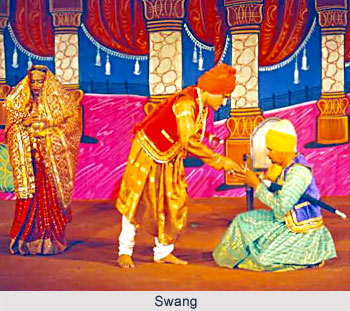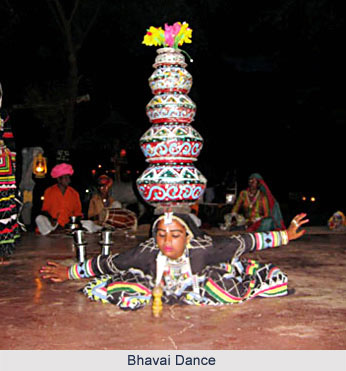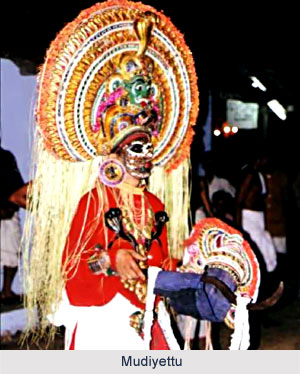 Types of traditional Indian theatres in India are varied with each Indian state having a distinct traditional theatrical form by itself. Bhand Pather, the traditional theatre form of Kashmir, is a distinctive combination of dance, music and acting. In this theatre form, music is provided with musical instruments such as surnai, nagaara and dhol. Satire, wit and parody are introduced here for inducing laughter. Since the actors of Bhand Pather are primarily from the farming community, the impact of their way of living, ideals and compassion is noticeable. Originally the theatre form Swang, was mainly music-based but gradually, prose played an important role in the dialogues. The softness of emotions, accomplishment of rasa along with the expansion of character is seen in this theatre form. The two important styles of Swang are from Rohtak and Hathras. In the style belonging to Rohtak, the language used is Haryanvi (Bangru) and in Hathras, the language is Braj Bhasha.
Types of traditional Indian theatres in India are varied with each Indian state having a distinct traditional theatrical form by itself. Bhand Pather, the traditional theatre form of Kashmir, is a distinctive combination of dance, music and acting. In this theatre form, music is provided with musical instruments such as surnai, nagaara and dhol. Satire, wit and parody are introduced here for inducing laughter. Since the actors of Bhand Pather are primarily from the farming community, the impact of their way of living, ideals and compassion is noticeable. Originally the theatre form Swang, was mainly music-based but gradually, prose played an important role in the dialogues. The softness of emotions, accomplishment of rasa along with the expansion of character is seen in this theatre form. The two important styles of Swang are from Rohtak and Hathras. In the style belonging to Rohtak, the language used is Haryanvi (Bangru) and in Hathras, the language is Braj Bhasha.
Traditional Theatre of Uttar Pradesh
The traditional theatre form, Nautanki, is generally associated with Uttar Pradesh. The most well known centres of this traditional theatre form are Kanpur, Lucknow and Hathras. The meters incorporated in the verses are Doha, Chhappai, Chaubola and Behar-e-tabeel. Previously only men acted in Nautanki but nowadays, even women have started taking part in the performances. Gulab Bai of Kanpur is one among those who is remembered with reverence. She gave a new dimension to this old theatre form. The theatrical form Raslila is based exclusively on Lord Krishna legends. In this theatre form the dialogues in prose are combined brilliantly with songs and scenes from Krishna`s life. Bhavai is the traditional theatre form of Gujarat. The chief centres of this form are Kutch and Kathiawar. The musical instruments used in Bhavai are bhungal, pakhaawaj, rabaab, tabla, bansuri, sarangi, manjeera, etc. In Bhavai, there is an unusual fusion of devotional and romantic sentiments.
Traditional Theatre of West Bengal
Fairs in honour of gods, or religious rituals and ceremonies within their framework of musical plays are known as Jatra. This form was born and nurtured in Bengal. Krishna Jatra became popular due to Chaitanya`s influence. Later, however, worldly love stories too, established a place in Jatra. Earlier Jatra was primarily musical. Dialogues were added at a much later stage. The actors themselves described the change of scene, the place of action, etc.

Traditional Theatre of Madhya Pradesh
The traditional theatre form of Madhya Pradesh is known as Maach. The term Maach is used for the stage and also for the play. In this theatre form, songs are given importance in between the dialogues. The term for dialogue in this form is bol and rhyme in narration is termed vanag. The tunes of this theatre form are known as rangat.
Traditional Theatre of Assam
Bhaona is a staging of the Ankia Nat of the state of Assam. In Bhaona cultural glimpses of Assam, Bengal, Orissa, Mathura and Vrindavan are reflected. The Sutradhar, or narrator begins the story, first in Sanskrit and then in either Brajaboli or Assamese.
Traditional Theatre of Maharashtra
Tamasha is a traditional folk theatre form of Maharashtra. It has evolved from the folk forms such as Gondhal, Jagran and Kirtan. In Tamasha the female actress is the chief exponent of dance movements in the play which is unlike the other theatrical forms. Classical music and vivid gestures make it possible to depict all the emotions through dance
Traditional Theatre of Goa
Dashavatar is the most developed theatre form of the Konkan and Goa regions. The performers embody the ten incarnations of Lord Vishnu, the god of preservation and creativity. The ten incarnations of Lord Vishnu are Matsya (fish), Kurma (tortoise), Varaha (boar), Narsimha (lion-man), Vaman (dwarf), Parashuram, Lord Rama, Lord Krishna (or Balarama), Lord Buddha and Kalki. Apart from stylised make-up, the Dashavatar performers wear masks of wood and papier mache. Krishnattam, folk theatre of Kerala, came into existence in the middle of 17th century A.D. under the patronage of King Manavada of Kolikod. This theatrical form is a cycle of eight plays performed for eight consecutive days. The plays are Avataram, Swayamvaram, Kaliamandana, Rasa krida, kamasavadha, Bana Yudham, Vivida Vadham, and Swargarohana. The episodes are based on the theme of Lord Krishna, his birth, childhood and different deeds illustrating the victory of good over evil.

Traditional Theatre of Kerala
The traditional folk theatre form of Kerala is known as Mudiyettu. It is celebrated in the month of Vrischikam (November-December). It is usually performed only in the temples of Goddess Kali and depicts the triumph of goddess Bhadrakali over the asura Darika. The seven characters in Mudiyettu-Shiva, Narada, Darika, Danavendra, Bhadrakali, Kooli and Koimbidar (Nandikeshvara) are all heavily made-up. Theyyam is a traditional and extremely popular folk theatre form of Kerala. Theyyam is performed by various castes to appease and worship these spirits. One of the distinctive features of Theyyam is the colourful costume and awe-inspiring headgears (mudi) nearly five to six feet high made of bamboos and wooden planks and dyed into different strong colours using turmeric, wax and arac.
One of the oldest traditional theatre forms of Kerala is Koodiyaattam which is based on Sanskrit theatre traditions. The characters of this theatre form are Chakyaar or actor, Naambiyaar, the instrumentalists and Naangyaar, those who portray the women`s roles. The Sutradhar or narrator and the Vidushak or jesters are the protagonists. It is the Vidushak alone who delivers the dialogues. Importance on hand gestures and eye movements makes this dance and theatre form unique. Yakshagaana, the traditional theatre form of Karnataka, is based on mythological stories and Indian Puranas. The most popular episodes are from the Mahabharata i.e. swayamvar of Draupadi, Subhadra vivah, Abhimanyu vadh, Karna-Arjun yudh and from Ramayana i.e. Rajyaabhishek, Lava-kusha Yudh and Panchavati.
Traditional Theatre of Tamil Nadu
In Tamil Nadu, Therukoothu is the most popular form of folk drama. It is generally performed at the time of annual temple festivals of Mariamman (Rain goddess) to achieve prosperous harvest. In Therukoothu there is a cycle of eight plays based on the life of Draupadi. Kattiakaran, the Sutradhara of the Therukoothu performance, gives the gist of the play to the audience and Komali entertains the audience with his buffoonery. The traditional theatre forms of Swang, Nautanki, Bhagat, etc. are usually similar. There is often stylistic variety, which toughens their distinctiveness.




